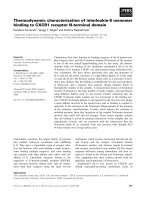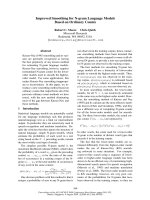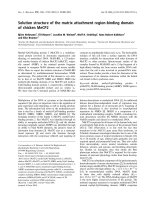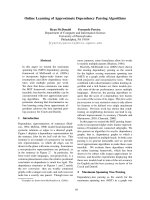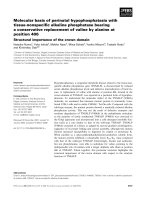Báo cáo khoa học: "Domain Adaptation of Maximum Entropy Language Models" potx
Bạn đang xem bản rút gọn của tài liệu. Xem và tải ngay bản đầy đủ của tài liệu tại đây (135.87 KB, 6 trang )
Proceedings of the ACL 2010 Conference Short Papers, pages 301–306,
Uppsala, Sweden, 11-16 July 2010.
c
2010 Association for Computational Linguistics
Domain Adaptation of Maximum Entropy Language Models
Tanel Alum
¨
ae
∗
Adaptive Informatics Research Centre
School of Science and Technology
Aalto University
Helsinki, Finland
Mikko Kurimo
Adaptive Informatics Research Centre
School of Science and Technology
Aalto University
Helsinki, Finland
Abstract
We investigate a recently proposed
Bayesian adaptation method for building
style-adapted maximum entropy language
models for speech recognition, given a
large corpus of written language data
and a small corpus of speech transcripts.
Experiments show that the method con-
sistently outperforms linear interpolation
which is typically used in such cases.
1 Introduction
In large vocabulary speech recognition, a language
model (LM) is typically estimated from large
amounts of written text data. However, recogni-
tion is typically applied to speech that is stylisti-
cally different from written language. For exam-
ple, in an often-tried setting, speech recognition is
applied to broadcast news, that includes introduc-
tory segments, conversations and spontaneous in-
terviews. To decrease the mismatch between train-
ing and test data, often a small amount of speech
data is human-transcribed. A LM is then built
by interpolating the models estimated from large
corpus of written language and the small corpus
of transcribed data. However, in practice, differ-
ent models might be of different importance de-
pending on the word context. Global interpola-
tion doesn’t take such variability into account and
all predictions are weighted across models identi-
cally, regardless of the context.
In this paper we investigate a recently proposed
Bayesian adaptation approach (Daume III, 2007;
Finkel and Manning, 2009) for adapting a con-
ditional maximum entropy (ME) LM (Rosenfeld,
1996) to a new domain, given a large corpus of
out-of-domain training data and a small corpus
of in-domain data. The main contribution of this
∗
Currently with Tallinn University of Technology, Esto-
nia
paper is that we show how the suggested hierar-
chical adaptation can be used with suitable pri-
ors and combined with the class-based speedup
technique (Goodman, 2001) to adapt ME LMs
in large-vocabulary speech recognition when the
amount of target data is small. The results outper-
form the conventional linear interpolation of back-
ground and target models in both N-grams and
ME models. It seems that with the adapted ME
models, the same recognition accuracy for the tar-
get evaluation data can be obtained with 50% less
adaptation data than in interpolated ME models.
2 Review of Conditional Maximum
Entropy Language Models
Maximum entropy (ME) modeling is a framework
that has been used in a wide area of natural lan-
guage processing (NLP) tasks. A conditional ME
model has the following form:
P (x|h) =
e
i
λ
i
f
i
(x,h)
x
e
j
λ
j
f
j
(x
,h)
(1)
where x is an outcome (in case of a LM, a word),
h is a context (the word history), and x
a set of all
possible outcomes (words). The functions f
i
are
(typically binary) feature functions. During ME
training, the optimal weights λ
i
corresponding to
features f
i
(x, h) are learned. More precisely, find-
ing the ME model is equal to finding weights that
maximize the log-likelihood L(X; Λ) of the train-
ing data X. The weights are learned via improved
iterative scaling algorithm or some of its modern
fast counterparts (i.e., conjugate gradient descent).
Since LMs typically have a vocabulary of tens
of thousands of words, the use of a normalization
factor over all possible outcomes makes estimat-
ing a ME LM very memory and time consuming.
Goodman (2001) proposed a class-based method
that drastically reduces the resource requirements
for training such models. The idea is to cluster
301
words in the vocabulary into classes (e.g., based
on their distributional similarity). Then, we can
decompose the prediction of a word given its his-
tory into prediction of its class given the history,
and prediction of the word given the history and
its class :
P (w|h) = P (C(w)|h)· P (w|h, C(w)) (2)
Using such decomposition, we can create two ME
models: one corresponding to P (C(w)|h) and the
other corresponding to P(w|h, C(w)). It is easy to
see that computing the normalization factor of the
first component model now requires only looping
over all classes. It turns out that normalizing the
second model is also easier: for a context h, C(w),
we only need to normalize over words that belong
to class C(w), since other words cannot occur in
this context. This decomposition can be further
extended by using hierarchical classes.
To avoid overfitting, ME models are usually
smoothed (regularized). The most widely used
smoothing method for ME LMs is Gaussian pri-
ors (Chen and Rosenfeld, 2000): a zero-mean
prior with a given variance is added to all feature
weights, and the model optimization criteria be-
comes:
L
(X; Λ) = L(X; Λ) −
F
i=1
λ
2
i
2σ
2
i
(3)
where F is the number of feature functions. Typi-
cally, a fixed hyperparameter σ
i
= σ is used for
all parameters. The optimal variance is usually
estimated on a development set. Intuitively, this
method encourages feature weights to be smaller,
by penalizing weights with big absolute values.
3 Domain Adaptation of Maximum
Entropy Models
Recently, a hierarchical Bayesian adaptation
method was proposed that can be applied to a large
family of discriminative learning tasks (such as
ME models, SVMs) (Daume III, 2007; Finkel and
Manning, 2009). In NLP problems, data often
comes from different sources (e.g., newspapers,
web, textbooks, speech transcriptions). There are
three classic approaches for building models from
multiple sources. We can pool all training data and
estimate a single model, and apply it for all tasks.
The second approach is to “unpool” the data, i.e,
only use training data from the test domain. The
third and often the best performing approach is to
train separate models for each data source, apply
them to test data and interpolate the results.
The hierarchical Bayesian adaptation method
is a generalization of the three approaches de-
scribed above. The hierarchical model jointly
optimizes global and domain-specific parameters,
using parameters built from pooled data as priors
for domain-specific parameters. In other words,
instead of using smoothing to encourage param-
eters to be closer to zero, it encourages domain-
specific model parameters to be closer to the
corresponding global parameters, while a zero
mean Gaussian prior is still applied for global pa-
rameters. For processing test data during run-
time, the domain-specific model is applied. Intu-
itively, this approach can be described as follows:
the domain-specific parameters are largely deter-
mined by global data, unless there is good domain-
specific evidence that they should be different.
The key to this approach is that the global and
domain-specific parameters are learned jointly, not
hierarchically. This allows domain-specific pa-
rameters to influence the global parameters, and
vice versa. Formally, the joint optimization crite-
ria becomes:
L
hier
(X; Λ) =
d
L
orig
(X
d
, Λ
d
) −
F
i=1
(λ
d,i
− λ
∗,i
)
2
2σ
2
d
−
F
i=1
λ
2
∗,i
2σ
2
∗
(4)
where X
d
is data for domain d, λ
∗,i
the global
parameters, λ
d,i
the domain-specific parameters,
σ
2
∗
the global variance and σ
2
d
the domain-specific
variances. The global and domain-specific vari-
ances are optimized on the heldout data. Usually,
larger values are used for global parameters and
for domains with more data, while for domains
with less data, the variance is typically set to be
smaller, encouraging the domain-specific parame-
ters to be closer to global values.
This adaptation scheme is very similar to the ap-
proaches proposed by (Chelba and Acero, 2006)
and (Chen, 2009b): both use a model estimated
from background data as a prior when learning
a model from in-domain data. The main differ-
ence is the fact that in this method, the models are
estimated jointly while in the other works, back-
302
ground model has to be estimated before learning
the in-domain model.
4 Experiments
In this section, we look at experimental results
over two speech recognition tasks.
4.1 Tasks
Task 1: English Broadcast News. This recog-
nition task consists of the English broadcast news
section of the 2003 NIST Rich Transcription Eval-
uation Data. The data includes six news record-
ings from six different sources with a total length
of 176 minutes.
As acoustic models, the CMU Sphinx open
source triphone HUB4 models for wideband
(16kHz) speech
1
were used. The models have
been trained using 140 hours of speech.
For training the LMs, two sources were used:
first 5M sentences from the Gigaword (2nd ed.)
corpus (99.5M words), and broadcast news tran-
scriptions from the TDT4 corpus (1.19M words).
The latter was treated as in-domain data in the
adaptation experiments. A vocabulary of 26K
words was used. It is a subset of a bigger 60K
vocabulary, and only includes words that occurred
in the training data. The OOV rate against the test
set was 2.4%.
The audio used for testing was segmented
into parts of up to 20 seconds in length.
Speaker diarization was applied using the
LIUM SpkDiarization toolkit (Del
´
eglise et al.,
2005). The CMU Sphinx 3.7 was used for
decoding. A three-pass recognition strategy was
applied: the first pass recognition hypotheses
were used for calculating MLLR-adapted models
for each speaker. In the second pass, the adapted
acoustic models were used for generating a
5000-best list of hypotheses for each segment. In
the third pass, the ME LM was used to re-rank the
hypotheses and select the best one. During decod-
ing, a trigram LM model was used. The trigram
model was an interpolation of source-specific
models which were estimated using Kneser-Ney
discounting.
Task 2: Estonian Broadcast Conversations.
The second recognition task consists of four
recordings from different live talk programs from
1
/>models/
three Estonian radio stations. Their format con-
sists of hosts and invited guests, spontaneously
discussing current affairs. There are 40 minutes
of transcriptions, with 11 different speakers.
The acoustic models were trained on various
wideband Estonian speech corpora: the BABEL
speech database (9h), transcriptions of Estonian
broadcast news (7.5h) and transcriptions of radio
live talk programs (10h). The models are triphone
HMMs, using MFCC features.
For training the LMs, two sources were used:
about 10M sentences from various Estonian news-
papers, and manual transcriptions of 10 hours of
live talk programs from three Estonian radio sta-
tions. The latter is identical in style to the test data,
although it originates from a different time period
and covers a wider variety of programs, and was
treated as in-domain data.
As Estonian is a highly inflective language,
morphemes are used as basic units in the LM.
We use a morphological analyzer (Kaalep and
Vaino, 2001) for splitting the words into mor-
phemes. After such processing, the newspaper
corpus includes of 185M tokens, and the tran-
scribed data 104K tokens. A vocabulary of 30K
tokens was used for this task, with an OOV rate
of 1.7% against the test data. After recognition,
morphemes were concatenated back to words.
As with English data, a three-pass recognition
strategy involving MLLR adaptation was applied.
4.2 Results
For both tasks, we rescored the N-best lists in
two different ways: (1) using linear interpolation
of source-specific ME models and (2) using hi-
erarchically domain-adapted ME model (as de-
scribed in previous chapter). The English ME
models had a three-level and Estonian models a
four-level class hierarchy. The classes were de-
rived using the word exchange algorithm (Kneser
and Ney, 1993). The number of classes at each
level was determined experimentally so as to op-
timize the resource requirements for training ME
models (specifically, the number of classes was
150, 1000 and 5000 for the English models and
20, 150, 1000 and 6000 for the Estonian models).
We used unigram, bigram and trigram features that
occurred at least twice in the training data. The
feature cut-off was applied in order to accommo-
date the memory requirements. The feature set
was identical for interpolated and adapted models.
303
Interp. models Adapted models
Adapta-
tion data
(No of
words)
σ
2
OD
σ
2
ID
σ
2
∗
σ
2
OD
σ
2
ID
English Broadcast News
147K 2e8 3e5 5e7 2e7 2e6
292K 2e8 5e5 5e7 2e7 2e6
591K 2e8 1e6 5e7 2e7 2e6
1119K 2e8 2e6 5e7 2e7 5e6
Estonian Broadcast Conversations
104K 5e8 3e5 5e7 1e7 2e6
Table 1: The unnormalized values of Gaus-
sian prior variances for interpolated out-of-domain
(OD) and in-domain (ID) ME models, and hierar-
chically adapted global (*), out-of-odomain (OD)
and in-domain (ID) models that were used in the
experiments.
For the English task, we also explored the ef-
ficiency of these two approaches with varying
size of adaptation data: we repeated the exper-
iments when using one eighth, one quarter, half
and all of the TDT4 transcription data for interpo-
lation/adaptation. The amount of used Gigaword
data was not changed. In all cases, interpolation
weights were re-optimized and new Gaussian vari-
ance values were heuristically determined.
The TADM toolkit
2
was used for estimating ME
models, utilizing its implementation of the conju-
gate gradient algorithm.
The models were regularized using Gaussian
priors. The variance parameters were chosen
heuristically based on light tuning on develop-
ment set perplexity. For the source-specific ME
models, the variance was fixed on per-model ba-
sis. For the adapted model, that jointly models
global and domain-specific data, the Gaussian pri-
ors were fixed for each hierarchy node (i.e., the
variance was fixed across global, out-of-domain,
and in-domain parameters). Table 1 lists values
for the variances of Gaussian priors (as in equa-
tions 3 and 4) that we used in the experiments. In
other publications, the variance values are often
normalized to the size of the data. We chose not
to normalize the values, since in the hierarchical
adaptation scheme, also data from other domains
have impact on the learned model parameters, thus
2
/>it’s not possible to simply normalize the variances.
The experimental results are presented in Table
2. Perplexity and word error rate (WER) results of
the interpolated and adapted models are compared.
For the Estonian task, letter error rate (LER) is
also reported, since it tends to be a more indicative
measure of speech recognition quality for highly
inflected languages. In all experiments, using the
adapted models resulted in lower perplexity and
lower error rate. Improvements in the English ex-
periment were less evident than in the Estonian
system, with under 10% improvement in perplex-
ity and 1-3% in WER, against 15% and 4% for the
Estonian experiment. In most cases, there was a
significant improvement in WER when using the
adapted ME model (according to the Wilcoxon
test), with and exception of the English experi-
ments on the 292K and 591K data sets.
The comparison between N-gram models and
ME models is not entirely fair since ME models
are actually class-based. Such transformation in-
troduces additional smoothing into the model and
can improve model perplexity, as also noticed by
Goodman (2001).
5 Discussion
In this paper we have tested a hierarchical adapta-
tion method (Daume III, 2007; Finkel and Man-
ning, 2009) on building style-adapted LMs for
speech recognition. We showed that the method
achieves consistently lower error rates than when
using linear interpolation which is typically used
in such scenarios.
The tested method is ideally suited for language
modeling in speech recognition: we almost always
have access to large amounts of data from written
sources but commonly the speech to be recognized
is stylistically noticeably different. The hierarchi-
cal adaptation method enables to use even a small
amount of in-domain data to modify the parame-
ters estimated from out-of-domain data, if there is
enough evidence.
As Finkel and Manning (2009) point out, the
hierarchical nature of the method makes it possi-
ble to estimate highly specific models: we could
draw style-specific models from general high-level
priors, and topic-and-style specific models from
style-specific priors. Furthermore, the models
don’t have to be hierarchical: it is easy to gen-
eralize the method to general multilevel approach
where a model is drawn from multiple priors. For
304
Perplexity WER LER
Adaptation
data (No.
of words)
Pooled
N-
gram
Interp.
N-
gram
Interp.
ME
Adapted
ME
Interp.
N-
gram
Interp.
ME
Adapted
ME
Interp.
N-
gram
Interp.
ME
Adapted
ME
English Broadcast News
147K 290 255 243 230 27.2 26.3 25.9
292K 286 250 236 223 26.7 25.8 25.6
591K 280 243 228 215 26.6 25.9 25.6
1119K 272 232 217 204 26.2 25.6 24.9
Estonian Broadcast Conversations
104K 237 197 200 169 40.5 38.9 37.4 17.7 17.3 16.6
Table 2: Perplexity, WER and LER results comparing pooled and interpolated N -gram models and
interpolated and adapted ME models, with changing amount of available in-domain data.
instance, we could build a model for recognizing
computer science lectures, given data from text-
books, including those about computer science,
and transcripts of lectures on various topics (which
don’t even need to include lectures about computer
science).
The method has some considerable shortcom-
ings from the practical perspective. First, train-
ing ME LMs in general has much higher resource
requirements than training N-gram models which
are typically used in speech recognition. More-
over, training hierarchical ME models requires
even more memory than training simple ME mod-
els, proportional to the number of nodes in the hi-
erarchy. However, it should be possible to allevi-
ate this problem by profiting from the hierarchi-
cal nature of n-gram features, as proposed in (Wu
and Khudanpur, 2002). It is also difficult to deter-
mine good variance values σ
2
i
for the global and
domain-specific priors. While good variance val-
ues for simple ME models can be chosen quite re-
liably based on the size of the training data (Chen,
2009a), we have found that it is more demand-
ing to find good hyperparameters for hierarchical
models since weights for the same feature in dif-
ferent nodes in the hierarchy are all related to each
other. We plan to investigate this problem in the
future since the choice of hyperparameters has a
strong impact on the performance of the model.
Acknowledgments
This research was partly funded by the Academy
of Finland in the project Adaptive Informatics,
by the target-financed theme No. 0322709s06 of
the Estonian Ministry of Education and Research
and by the National Programme for Estonian Lan-
guage Technology.
References
Ciprian Chelba and Alex Acero. 2006. Adaptation of
maximum entropy capitalizer: Little data can help a
lot. Computer Speech & Language, 20(4):382–399,
October.
S. F. Chen and R. Rosenfeld. 2000. A survey of
smoothing techniques for ME models. IEEE Trans-
actions on Speech and Audio Processing, 8(1):37–
50.
S. F. Chen. 2009a. Performance prediction for expo-
nential language models. In Proceedings of HLT-
NAACL, pages 450–458, Boulder, Colorado.
Stanley F. Chen. 2009b. Shrinking exponential lan-
guage models. In Proceedings of HLT-NAACL,
pages 468–476, Boulder, Colorado.
H. Daume III. 2007. Frustratingly easy domain adap-
tation. In Proceedings of ACL, pages 256–263.
P. Del
´
eglise, Y. Est
´
eve, S. Meignier, and T. Merlin.
2005. The LIUM speech transcription system: a
CMU Sphinx III-based system for French broadcast
news. In Proceedings of Interspeech, Lisboa, Portu-
gal.
J. R. Finkel and Ch. Manning. 2009. Hierarchi-
cal Bayesian domain adaptation. In Proceedings of
HLT-NAACL, pages 602–610, Boulder, Colorado.
J. Goodman. 2001. Classes for fast maximum entropy
training. In Proceedings of ICASSP, Utah, USA.
H J. Kaalep and T. Vaino. 2001. Complete morpho-
logical analysis in the linguist’s toolbox. In Con-
gressus Nonus Internationalis Fenno-Ugristarum
Pars V, pages 9–16, Tartu, Estonia.
R. Kneser and H. Ney. 1993. Improved clustering
techniques for class-based statistical language mod-
elling. In Proceedings of the European Conference
305
on Speech Communication and Technology, pages
973–976.
R. Rosenfeld. 1996. A maximum entropy approach to
adaptive statistical language modeling. Computer,
Speech and Language, 10:187–228.
J. Wu and S. Khudanpur. 2002. Building a topic-
dependent maximum entropy model for very large
corpora. In Proceedings of ICASSP, Orlando,
Florida, USA.
306


